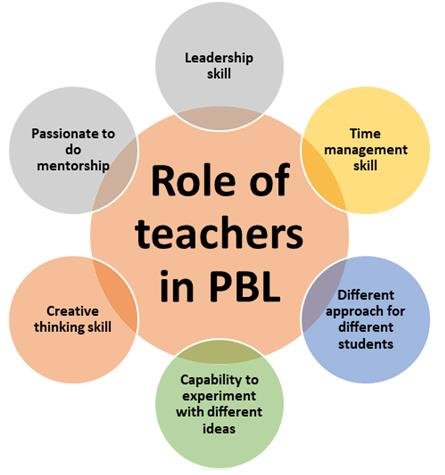Managing the Process / The Role of the Teacher
In this week’s resources I found two amazing pages one of them called “Bloomin’ apps” that gathered in just one page a number of apps (g suite apps, web apps, iPad or android apps) to support different levels of Bloom’s Taxonomy and the other “Learning Theories, Instructional Models and Styles” that gathered all the learning theories. These two pages are quite helpful as a reference for anyone who wants to have a quick glance at something.
I also liked the tips and comments/advices on the “Watershed project video” about managing a PBL project. Advices like keep track of what the groups are doing/check their progress in regular basis and have them report to you, because otherwise they will fall behind, then get overwhelmed trying to catch up and finally shut down. One more useful thing I got from that video was to make students reflect on what they have learned; I remember the phrase “reflection is retention”, which makes complete sense, because if you reflect on what you’ve learnt, it’s much more likely to retain this information.
Another thing that stuck with me from this week’s readings was about the role of the teacher in PBL projects; So, our readings were pointing out that in PBL projects and in many models that support effective use of technology, the role of the teacher is that of a facilitator, while the lessons should be more student-centered (constructivist approach). Teaching strategies have changed a lot over the years, from the teacher centered classroom, that most of us experienced during our youth, to the PBL classroom there is a very long way. Teachers are not the ones giving the answers anymore, they should provide support when and if needed but their main role during the project is to facilitate, in other words to provide empathy and inspiration, give feedback, ask guiding questions that push students to the correct direction, and help them peer assess and self reflect. In order to accomplish all that teachers have to be active listeners, good time keepers, objective and unbiased, flexible and ready to adapt to changing situations and of course observant. Furthermore, they are accountable for putting together a well-organized and planned project that can assist students reach clearly specified objectives.
I must admit that although I have not conducted a PBL project before, I am not alienated with the whole process. For twelve years in Greece I was teaching at a middle school that was following the International Baccalaureate MYP curriculum. The MYP curriculum also fosters inquiry, problem solving and experimentation, addresses general educational standards and creates student-centered learning environments. Students discover knowledge on their own through carefully designed and implemented projects, with the teacher acting as a helpful and facilitating figure. So I’ve seen firsthand how successful this educational strategy is and how driven and involved the students get in those settings. Students are thriving because they recognize the significance of what they are studying and how it ties to their personal goals and real-world problems. Furthermore, they learn to cooperate, be flexible, productive, and creative, interact successfully with their classmates, and acquire reading skills and a deeper knowledge of the modern world. PBL projects help students prepare for the world they will live in by giving them the tools and skills they will need to adapt and succeed.



![10th week’s reflection [8/3 – 8/5]](https://www.gkonstantinou.com/wp-content/uploads/2022/07/pbl-500x383.png)
![9th Week’s Reflection [7/27 – 8/2]](https://www.gkonstantinou.com/wp-content/uploads/2022/07/1_Q9bfz0wD837_Irn20O-ERA-500x383.jpeg)
![6th & 7th Week’s Reflection [7/6 – 7/19]](https://www.gkonstantinou.com/wp-content/uploads/2022/07/project-500x383.jpg)
![4th-5th Week’s Reflection [6/22 – 7/5]](https://www.gkonstantinou.com/wp-content/uploads/2022/06/bulletin-500x383.jpg)
![3rd Week’s Reflection [6/12 – 6/21]](https://www.gkonstantinou.com/wp-content/uploads/2022/06/site-500x383.jpg)